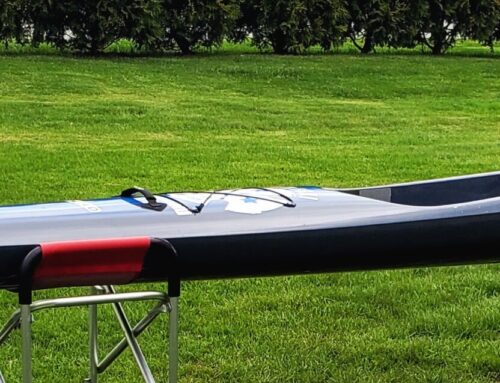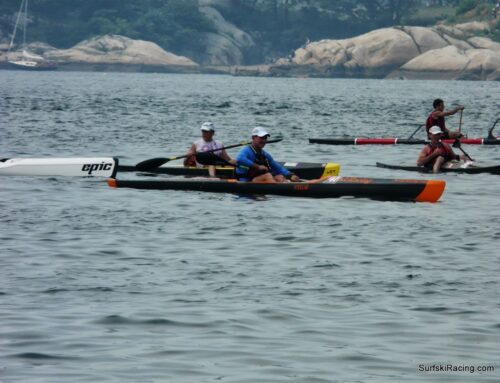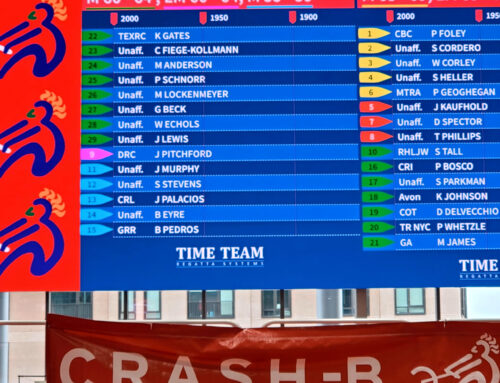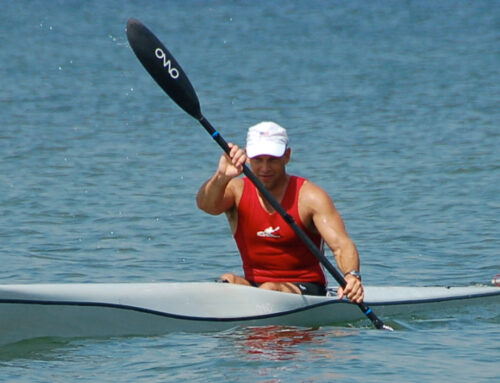Why do you want to surfski? There are a number of reasons, some more important than others, depending on the person. On a surfski, you go fast, real fast. I believe they are the fastest all-around human powered water craft in the world, equally at home in dead calm conditions as they are in a gale. Some love to race. Personally I love riding waves, big wind-driven waves or hurricane generated ground swells, as well as the challenge of just paddling in 20+ knot wind conditions. A big plus, they are relatively light compared with other kayaks and you do not need all that much equipment when you head out.
I learned to surfski (on my kevlar Think Evo) this past year over about 7 months. I live in Rhode Island, the northeast coast of the US, and have the advantage of easy access to Narragansett Bay and coastal ocean waters. Over this time, I have put in about 185 hours on my ski during 90+ sessions, each session generally lasting from 1.5 to 2.5 hours, although as I have gotten better, I look forward to some longer paddles on the weekends. I offer this information not as an expert, which I certainly am not, but as the perspective of someone who has recently gone through the trials and tribulations of going from the point of virtually zero skill to the point where I can go out and paddle for a couple hours in 20+ knot winds with 5 foot seas, and love every second of it.
I am not going to offer anything about technique, since I am not qualified to and others could do that much better than I, but rather more about the learning process and how it evolved for me. This is only my perspective; it all may or may not mesh with the experience of others, but this is how it worked for me.
If you do not have a ski yet or just got one, read everything you can about the experiences of others, techniques, safety, etc. Since this is not yet a super big sport in terms of the relative numbers of participants (at least here in the states), there is a lot less material out there than there is for other sports; however, if you search the web, talk to others, read forums, watch videos, etc., over a short time you can put together a pretty good picture of what it all entails.
Even if you can only get out for an hour/day it is well worth it. Only paddling once a week will take you a long time to develop skills in wind/waves; and, quite frankly, I am not sure you will ever “get it” by paddling only 1x/week. To develop, one thing that this sport requires is a commitment to get out and paddle in wind/waves several times a week for as many weeks as it takes to achieve the desired level of proficiency.
On flat water, it took me about 10 minutes to learn how to stay on the ski, do remounts, and develop a rudimentary paddle stroke. Wind/wave conditions are another matter altogether. It will take some time paddling in wind/waves to get “over the hump”. What I mean by this is to get to the point where you are not falling off all the time, and, just as important from a psychological standpoint, are not worried about falling off all the time. For me, this required about 5 or so hours in wind/wave conditions. Since I had these conditions about half the time I paddled, it took me a couple weeks. Up until that point, in wind/waves, I found myself sometimes wondering what these other folks have that I don’t, and, “will I ever get it?” All I can say is that if you get out there in the wind/waves consistently, you WILL get it. As I read somewhere else on the web, the only folks who would be laughing at you while watching you constantly fall off and get back on a surfski while learning are those who have never done it; those who have appreciate the effort and persistence it takes.
In the beginning you are using your conscious mind to try and adapt your body position and stroke to the waves. This, you will find, does not work. Your mind is just not fast enough to process and react to all of this in the conscious state. As you progress, your subconscious begins to take more and more control and you will find your body and arms correcting and accounting for waves without you being aware of it.
Once you get over the hump, then the real fun begins. It is extremely liberating as you can start concentrating on technique in the waves. After this point, the learning curve becomes such that you feel measured improvement every time you go out. I found that from about hour 10 to hour 50, the proficiency increase was remarkable. Each time I went out in this time period, I felt much improved from the previous session. This in itself becomes an incredible psychological driver, i.e., you see so much improvement, it makes you want to go out even more, you then improve more, you go out more, and on and on.
Some things to be aware of:
• In the beginning, you are going to get wet (i.e. swim), a lot. Expect it, get used to it, enjoy it.
• Flat water only paddling will get you nowhere in terms of wind/wave skill; but,
• At the start, high wind/waves only paddling will keep you in the water with the only skill developing being your remount techniques, so go out in both flat water and waves.
• Having said that, remounting technique is critical, especially in high wind/waves. In early wind/wave conditions, stay close to shore and practice a lot, both techniques (side saddle and straddle), and from both sides. Practice getting your remount time down to seconds. Talk yourself through it beforehand and as you do it.
• Flat water paddling is good to develop your stroke; then,
• Wind and waves will develop your balance and use of that stroke,
• If possible, in the beginning, alternate paddling from flat to wind/waves on successive days.
• As you develop, talk to others, read different “how-to” articles, and watch videos for forward stroke and downwind techniques. Each person will have a slightly different perspective; this is very helpful as you will relate to some better than others (Oh, and take a lesson from Oscar Chalupsky or the likes if you have the opportunity – it’s awesome!).
• The most important lesson: GET OUT OFTEN. The brain develops and learns new skills by practicing, sleeping on it, and then doing again. It is amazing, you can struggle all afternoon trying to do something, sleep on it, then the next day, you feel like you are 100% better – and you are! How does it work? I am not a neuroscientist, so read these if you want a clue: Brain Learnings: Sleep and Learning and Learning Motor Skills. The point being, it would be better to do 3 one-hour sessions three days in a row than to do a single three-hour session in one day.
To monitor and concentrate on your paddling stroke, try this: on days when the water is flat or near flat, shut your eyes while paddling. Because visual distractions are no longer interfering, you will become very aware of your body movement related to your stroke. You can then think back to all the write-ups and videos you read and watched and concentrate on those things. Later on, try closing your eyes in wind/wave conditions at all angles to the sea; your body must learn to react and counter wave movements by sensing and responding instantaneously to motion alone without any visual cues – what a way to improve your balance!
As you progress, keep pushing yourself to paddle in conditions (wind/waves) that are just a little beyond your comfort zone. The comfort zone will thus extend a little bit more each time.
Once you get better and stop falling off, don’t neglect your remount techniques. Think about it, once you have progressed to the point where you hardly ever fall off, then, by definition, you are then most likely to fall off in big water conditions, which is exactly when you need that bombproof remount! Periodically, I go out on big wind/wave days to a place where the onshore waves are pushing into a protected area. Here I paddle around for a while and then purposely broach the boat and fall in head first on the downwind side. If for some reason I cannot get back on, the onshore conditions would push me into the protected area where I will be able to get back on. Keep practicing the remounts until you have it down cold. Although you will likely favor one or the other, both remount techniques should be learned. Generally speaking, the side saddle is easier, and I use it more often. But, in my opinion, while the straddle takes more energy to perform, it is faster and the most reliable in really big water conditions when you are in the “washing machine” with 5 foot waves and wakes coming at you from multiple directions.
While you may spend much of your time paddling either upwind or downwind, practice paddling in varied seas in big conditions, i.e., beam seas, front quarter seas, and rear quarter seas, all on both sides. You will see that the boat reacts differently and requires different balance and braces. For example, I have found that a steep rear quarter sea will tend to slap the back of the ski so that pushes it into a beam sea if you let it. The beam sea (direct side on) is probably the most difficult for balance, but, you will need this skill, so get out there and practice it (i.e. purposely putting yourself in a high beam sea, getting pushed off, getting back on, and trying again).
Slop and chop: the phrase I use for seas with good wind generated waves which have become totally confused by multiple boat wakes going all different directions (and/or waves refracting off of nearby cliffs and such). Since I live in a popular boating area in the summer, we have lots of boats/ships of all sizes putting their wakes in the water, especially on the weekends. When you combine the myriad of wakes with some strong wind generated seas, you have perhaps the hardest seas of all, but once you get it, and can paddle in any direction you want to go without falling off, you have arrived…
So, in 7 months and 185 hours, going out 3 to 4 times a week, always trying to push my comfort zone a little further, I have succeeded in being completely comfortable in my Evo in almost any conditions we get around here. I will regularly put in when the marine forecast calls for winds to 20+ knots and seas to 5 feet or more. Periodically, we have some big ocean storms or hurricanes far off the coast of New England that will generate 8-10 foot ground swells as they enter the mouth of the bay. I now live for these as last fall I managed to record 19.1 miles per hour max speed on my GPS riding one of these babies. I don’t think I can stop doing this – neither will you. ~ Bill






Leave A Comment
You must be logged in to post a comment.